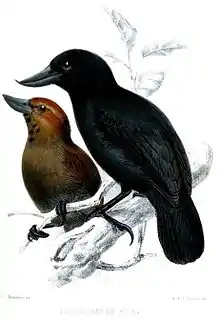| Clytoctantes | |
|---|---|
 | |
| Recurve-billed bushbird (Clytoctantes alixii) | |
| Scientific classification | |
| Domain: | Eukaryota |
| Kingdom: | Animalia |
| Phylum: | Chordata |
| Class: | Aves |
| Order: | Passeriformes |
| Family: | Thamnophilidae |
| Genus: | Clytoctantes Elliot, 1870 |
| Type species | |
| Clytoctantes alixii[1] Elliot, 1870 | |
| Species | |
|
See text | |
Clytoctantes is a South American genus of passerine birds in the antbird family, Thamnophilidae. Males are grey or black and females are mainly rufous. The stubby, hefty bill has a distinctly upcurved lower mandible and a straight culmen (a large version of the bills of the recurvebills), which possibly is a modification for opening bamboo stems in their search for insects. The two species were feared to be extinct or nearly so, until both were rediscovered in 2004.
Species
- Recurve-billed bushbird (Clytoctantes alixii)
- Rondônia bushbird (Clytoctantes atrogularis)
The name "bushbird" is shared with the rather similar, but smaller-billed black bushbird from the monotypic genus Neoctantes.
References
- ↑ "Thamnophilidae". aviansystematics.org. The Trust for Avian Systematics. Retrieved 2023-07-16.
This article is issued from Wikipedia. The text is licensed under Creative Commons - Attribution - Sharealike. Additional terms may apply for the media files.